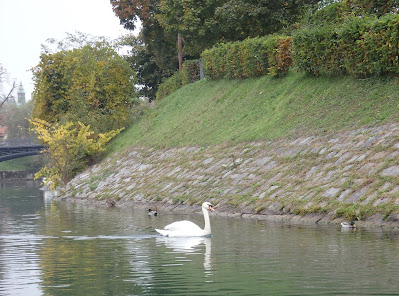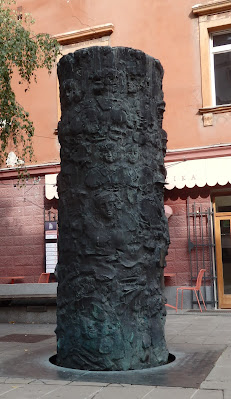 |
| From the port of Koper, Slovenia, I took a bus trip to tour the capital city of Ljubljana. Like anywhere else, if the weather is nice, there's road construction. |
 |
| Don't know if this is sumac but, whatever it is, the fall colors made the hillside pretty. |
 |
| Once in Ljubljana, we exited the buses and headed to these little boats for a ride down the Ljubljanica River from Prule Bridge through the heart of the city to just past the Dragon Bridge. |
 |
| So the trip starts with buildings built back from the edge of the river. |
 |
| Seems Ljubjana, is often fog-bound the first half of the morning with the clouds clearing around 11 am. |
 |
| The ducks and swans were also enjoying the day. |
 |
| We started the float under the Prule Bridge. Our second bridge was Hradeckega most. |
 |
| Nothing like a balcony hanging over the river. |
 |
| Through the fog we could see the clock tower of Ljubljana Castle that sits on a hill surrounded by the old town. |
 |
 |
| Butcher's Bridge, site where hundreds of lovers have symbolically padlocked their love and dropped the keys into the river Ljubljanica |
 |
| The Church of the Anunciation comes into view. |
 |
| Our trip takes us to Dragon Bridge where we turn around. Any guess on why it's called Dragon Bridge? |
 |
| The alley ends with a drinking fountain and a couple other odd sculptures, namely a bronze hand and a skeleton trapped in a cage |
 |
| The alley ended at Mestni Trg, an old market street. |
 |
| An ingenious way to heat up an outside area on a cold day. Saw lots of heaters and people sitting outside. |
 |
| Another view of Ljubljana Castle as we cross back over the river on Cobbler's Bridge. |
 |
| University of Ljubljana (formerly the Carniolan State Mansion) is at the southeast corner of the Square. |
 |
| Fountain in front of the University building. |
 |
| Ursuline Church of the Holy Trinity is an 18th century baroque Catholic church that sits on the west side of the square. |
 |
| The water in Ljubljana is good for drinking and bottled water is a rarity in the city. |
 |
| It is part of the pedestrian zone in Ljubljana’s Old Town and a very popular meeting point. Great place for this bronze relief map of the Old City. |
 |
| Urbanc Palance. also located in Presherna Square is now the Galerija Emporium |
 |
| Bicycles were everywhere. |
 |
| We started walking along the river again and could see buildings across the way. This old building is now a shopping center on the bottom floors. |
 |
| Rental bikes in case you are visiting without one. |
 |
| There were several interesting sculptures along the embankment. |
 |
| This one is on Butcher's Bridge. |
 |
| View of Triple Bridge from Butcher's Bridge |
 |
| Crossing the bridge we ended up at the Farmer's Market. Lots of produce and even clothing stalls on the far side. |
 |
| And everyone needs a candle to go to the church, so a wide variety was offered. |
 |
| To me the most interesting thing was this fresh milk dispenser. |
 |
| And this egg dispenser. |
 |
| Cathedral side door relief with portraits of bishops |
 |
| Continuing our walk along Mestni Trg. |
 |
| We walked past Robba Fountain for this photo looking back toward the Cathedral. More on the fountain later. Now it's time to eat. |
 |
| We were greeted at the door to the restaurant by this cheerful figure. |
 |
| The large crowd was taken upstairs and sat at long tables. |
 |
| The first course was soup in a bread bowl. |
 |
| The main entree was pork and potatoes |
 |
| Don't ask me what was for dessert. I just ate what they put in front of me. |
 |
| Heading back down the multiple layers of the historic building where the restaurant was located. |
 |
| One area had a skylight so there was an opening down to the lower level. |
 |
| In the center of Town Square is the Fountain of Three Carniolian Rivers (Robba Fountain), a top Ljubljana Baroque monument that was sculpted in the mid-1700’s. |
 |
| On the way back to Koper, I finally got a photo of the exit signs. Loved how they showed you what attractions could be found at the exit. |






























